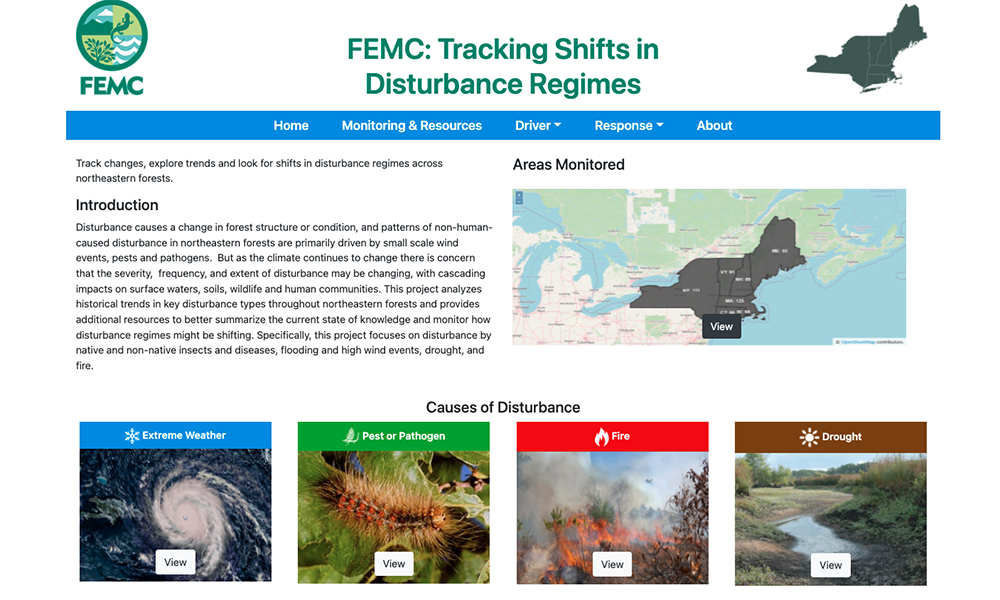Tracking Shifts in Natural Disturbance Events: Using FEMC’s New Online Tool
Feb. 3rd 2022How does the changing climate impact disturbance events in the Northeast region? How will these disturbance events affect water, soil, wildlife, and human communities? The Forest Ecosystem Monitoring Cooperative (FEMC) has released a new online tool to target these questions.
FEMC launched the tool, called “Tracking Shifts in Disturbance Regimes,” in October of 2021 as one of their two regional projects for the 2020-2021 year. The Disturbance project analyzes historical trends in key disturbance types throughout northeastern forests by native and non-native insects and diseases, flooding and high wind events, drought, and fire. The project also provides additional resources to better summarize the current state of knowledge about disturbance and to monitor how disturbance regimes might be shifting.
Why focus on disturbance regimes? Jim Duncan, Executive Director of the FEMC, explains, “We hear a lot of questions from our partners and cooperators about whether key disturbances like high winds and drought in the Northeast are changing with climate.”
Duncan and other developers of the project noticed that there was already a lot of research and monitoring focused on disturbance in the Northeast region. “What seemed to be lacking in our region is that quick snapshot of change,” Duncan said. “With this tool, people working in the forest sector will have access to a quick [summary] of authoritative data to see for themselves how disturbances are or aren’t changing over time.”
The Disturbance project has three outputs: a filterable database, an analysis of trends in disturbance regimes, and a visual mapping tool. The database allows users to quickly access historical databases related to specific disturbance drivers, such as extreme weather events. Users can then see a visual analysis of the frequency, extent, severity, and location of each type of disturbance. A map also allows the user to filter disturbance datasets by location throughout the whole region.
The FEMC worked with partners and experts in the field to select seven drivers of disturbance, sorted into four main categories:
1). Extreme Weather (Flood; High Winds)
2). Pest or Pathogen (Advancing Invasives; Native Pests; Established Invasives)
3). Fire
4). Drought
Users can interact with the visualizations of the frequency, extent, severity, and location of each driver by filtering for location and other metrics. The webpage features a description of that type of disturbance as well as highlights of events related to that disturbance in the region. The tool provides additional data resources with information about time scales and the organization that conducted the study. If the data is publicly available, the link is provided.
The project also highlights three types of disturbance responses: stream macroinvertebrates, cold-water fisheries, and invasive plants. Disturbance events directly impact these three entities, which makes them ideal indicators of the impact of disturbances. FEMC curated data programs related to the monitoring of these three systems. Again, users can access publicly available data and learn more about each project.
While the online tool gives users full access to explore their own interests and questions, FEMC highlighted some of the key trends in this webinar on tracking disturbances. For example, a regional-level analysis found that high winds are not getting more severe or more frequent, but they are happening in more locations. Additionally, fires are increasing in frequency but not burning more overall area. Analysis found that certain pests like the forest tent caterpillar and spruce budworm are having less impact, but the impacts of others such as browntail moth and Lymantria dispar are becoming more severe.
Increasing awareness of these trends can help inform future research questions, policy decisions, and management. As more researchers contribute data and studies to the tool, the trends will only provide stronger guidance for future work in this area.
For Duncan, this tool has a lot of room to grow. He said, “Looking ahead, I hope to see our partners take an interest in this tool, work on expanding its utility with more context and interpretation, add more disturbance monitoring programs to the catalog, and use this information to advocate for responsive policy and management that will be prepared to deal with disturbance now and into the future.”
FEMC is a partnership of northeastern state agencies, the University of Vermont, and the USDA Forest Service. Annually, FEMC selects and conducts its regional projects in collaboration with a regional advisory committee.
 ecoNEWS VT
ecoNEWS VT